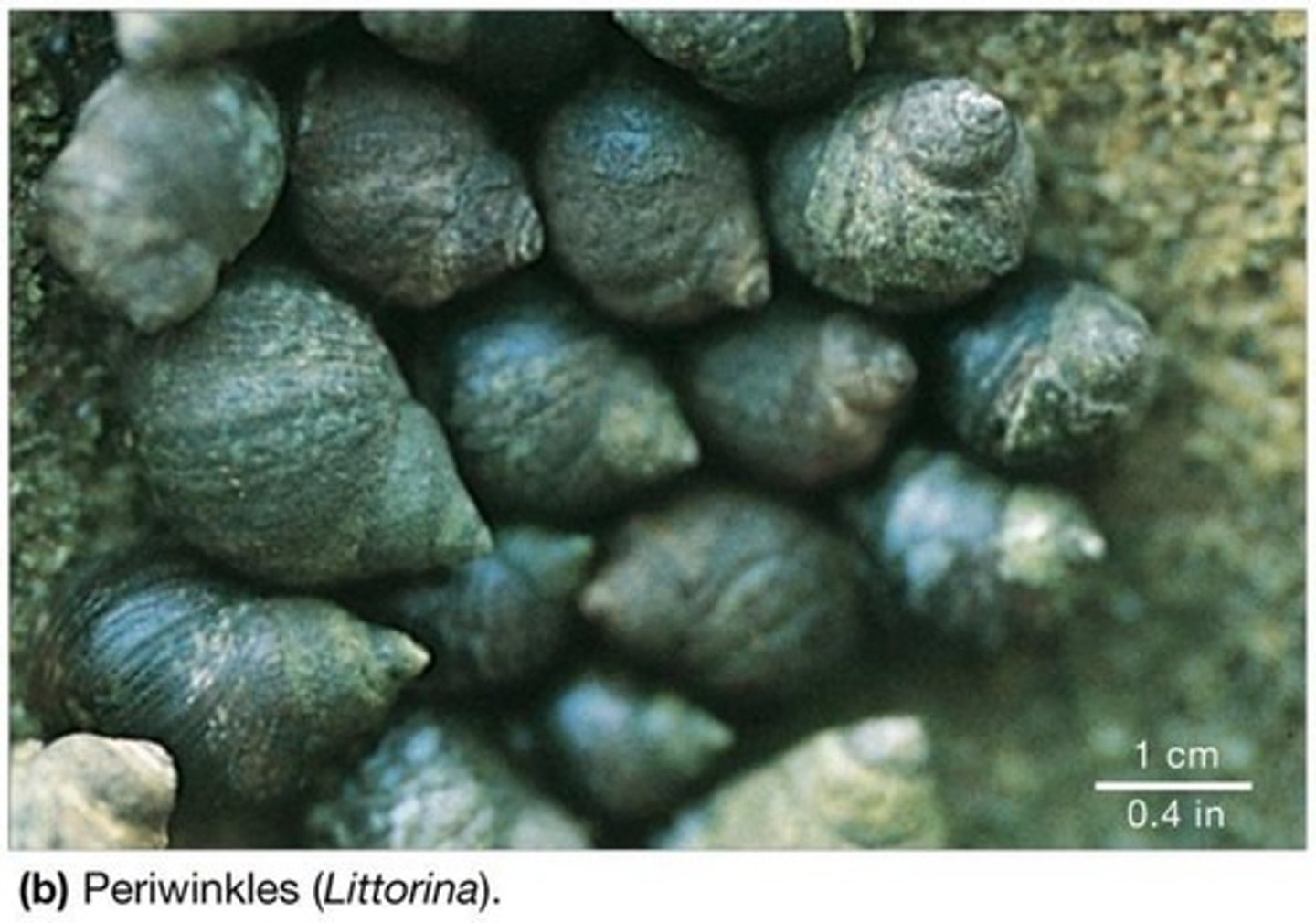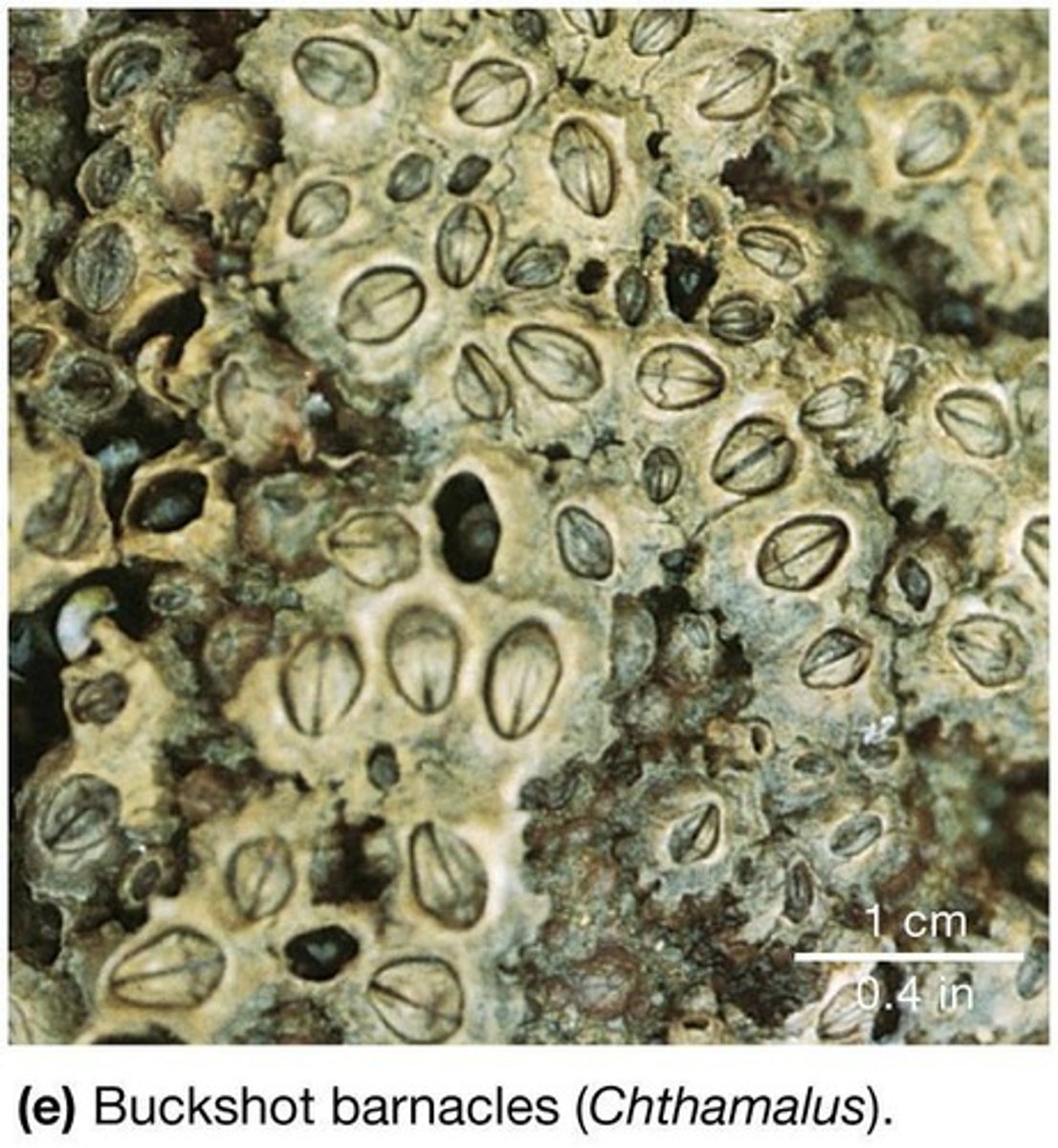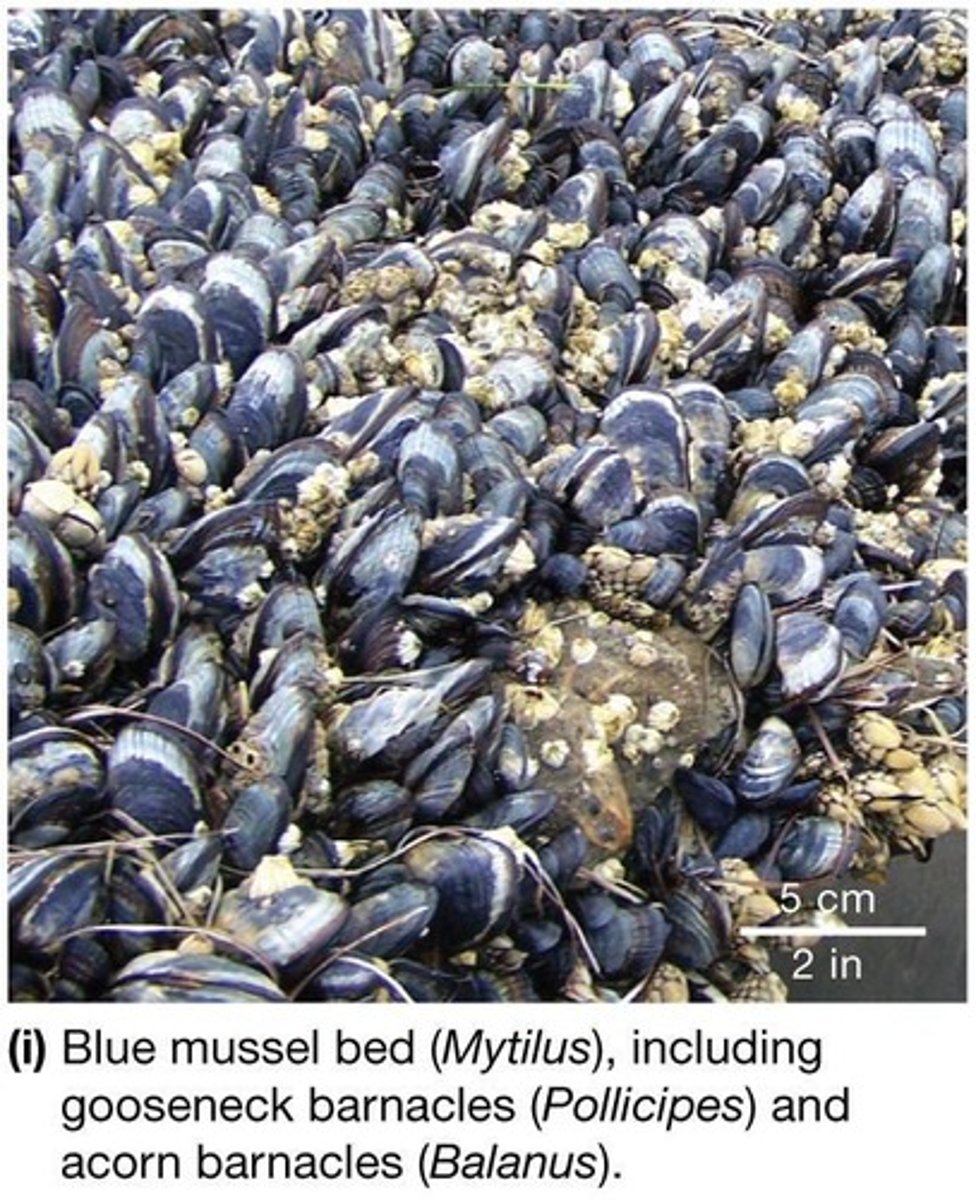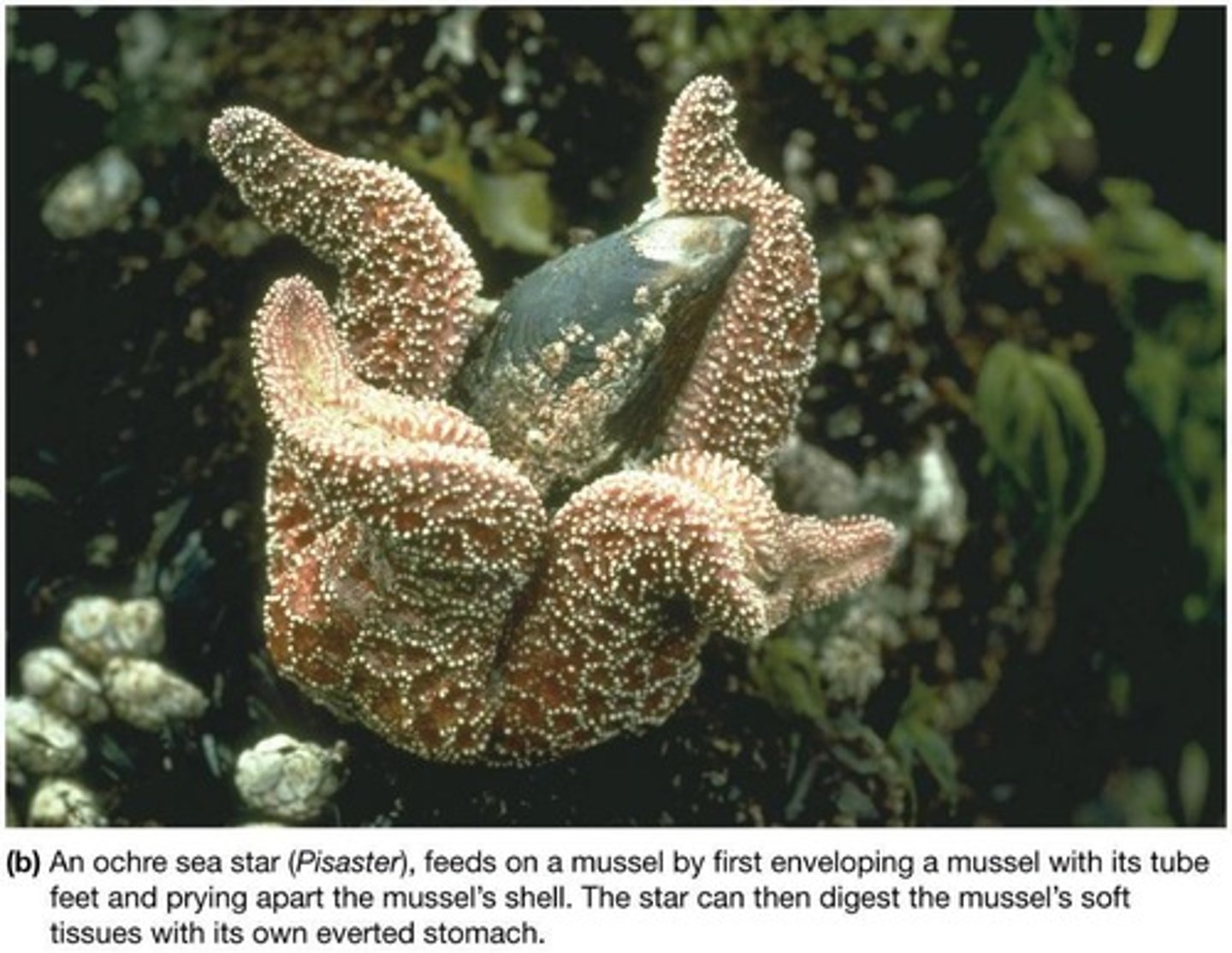Chapter 15: Animals of the Benthic Environment
1/126
There's no tags or description
Looks like no tags are added yet.
Name | Mastery | Learn | Test | Matching | Spaced |
|---|
No study sessions yet.
127 Terms
What percentage of known marine species live in or on the ocean floor?
More than 98% of ~250,000 known marine species.
Where do benthic organisms primarily live?
Mainly on continental shelves.
What environmental factor affects benthic diversity?
Surface ocean currents and temperature dictate species assemblages/diversity.
How does benthic biomass relate to surface chlorophyll distribution?
Benthic biomass matches surface chlorophyll distribution.
What is the relationship between primary productivity in surface waters and the sea floor?
High primary productivity results in greater carbon flux (detritus sinking) to the sea floor.
What are epifauna?
Organisms that live on or are attached to benthic substrate, such as marine algae, and can move over the sea floor.
What is the diversity of species like in rocky intertidal zones?
Moderate diversity of species, with greatest animal diversity at tropical latitudes and greatest algae diversity at mid-latitudes.
What are the three zones of intertidal zonation?
High tide zone, middle tide zone, and low tide zone.
What characterizes the spray zone in intertidal zonation?
It is continually above sea level and contains organisms that avoid desiccation.
What adaptations do organisms in the spray zone have to avoid desiccation?
Many animals have shells and few species of marine algae are present.
Name two organisms found in the spray zone.
Periwinkle snail and rock louse.

What is the condition of the high tide zone?
It is relatively dry and animals have shells to avoid drying out.
What determines the upper limit of intertidal zonation?
Generally abiotic factors set the upper limit.
What determines the lower limits of intertidal zonation?
Biotic factors determine the lower limits.
What are the characteristics of communities on sediment-covered shores?
(Note: Specific characteristics not provided in the notes; consider general knowledge or further study.)
What are the characteristics of communities on the shallow offshore ocean floor?
(Note: Specific characteristics not provided in the notes; consider general knowledge or further study.)
What are the characteristics of communities on the deep-ocean floor?
(Note: Specific characteristics not provided in the notes; consider general knowledge or further study.)
What are rock weeds and their significance in marine ecosystems?
Rock weeds, such as Fucus, have thick cell walls that reduce water loss and are among the first organisms to colonize rocky shores.
Which animals are typically found in the middle tide zone?
The middle tide zone is home to sessile animals like barnacles (e.g., Chthamalus), soft-bodied animals, acorn barnacles, mussels, sea stars, and carnivorous snails.

What role does Pisaster play in the middle tide zone?
Pisaster is a keystone species that preys on mussels, influencing the community structure of the middle tide zone.

What adaptations do hermit crabs have for survival in the intertidal zone?
Hermit crabs have armored claws, a five-toothed mouth, and inhabit abandoned shells, providing protection for their soft abdomen.
What characterizes the low tide zone in marine ecosystems?
The low tide zone is almost always submerged, has abundant algae and surf grass, and supports a diverse community of animals that often hide among the vegetation.

How do shore crabs adapt to their environment in the intertidal zones?
Shore crabs are scavengers that keep the shore clean, hide in rock cracks during the day to minimize desiccation, and have a hard exoskeleton to prevent dehydration.
What is the relationship between sediment particle size and energy levels in intertidal zones?
Sediment particle size and stability are related to energy levels; low-energy mud-flats have more stable sediment than sandy beaches.
What types of organisms are found in sandy beach environments?
Sandy beach organisms include infauna like bivalve mollusks (clams, mussels), annelid worms, crustaceans (sand crabs), echinoderms (sand stars), and meiofauna.
What is the role of meiofauna in sandy beach ecosystems?
Meiofauna are small marine organisms that live between sediment particles and feed on bacteria found on the surface of those particles.
What adaptations do fiddler crabs exhibit in mud flats?
Fiddler crabs dig burrows in mud flats, with males having one large claw for courtship and competition, while females have two normal-sized claws.
What defines the subtidal zone in marine environments?
The subtidal zone extends from the spring low-tide shoreline to the edge of the continental shelf and is primarily sediment-covered with some rocky outcrops.
What is the ecological significance of kelp forests?
Kelp forests are fast-growing, highly productive ecosystems that provide shelter, food, living space, spawning grounds, and nursery habitat for various marine organisms.
What are the characteristics of lobsters in rocky bottom communities?
Lobsters are scavengers that also feed on live animals and undergo lengthy migrations, living in relatively deeper water.
How do oysters contribute to their ecosystem?
Oysters are sessile bivalve mollusks that form beds, require clean water and plankton, and serve as food for various predators, including sea stars and crabs.
What is the significance of coral reefs in marine biodiversity?
Coral reefs are biogenic communities predominantly made of CaCO3, found in shallow tropical waters, and support high biodiversity, with up to ~50 genera.
What are polyps in the context of coral reefs?
Polyps are the individual organisms that make up larger coral colonies, contributing to the structure and function of coral reefs.

What is the relationship between coral reef distribution and water temperature?
Coral reefs are restricted to tropics where water temperatures exceed 18°C throughout the year.
What factors influence the diversity of species in shallow offshore communities?
The diversity of species in shallow offshore communities is influenced by sediment type, presence of rocky outcrops, and upwelling zones that enhance pelagic productivity.
What adaptations do sand crabs have for their environment?
Sand crabs have a segmented body, hard exoskeleton, and paired jointed limbs, allowing them to filter food from water and stay hidden in sand.
What is the significance of the rocky bottom in shallow offshore communities?
Rocky bottoms provide habitats for various organisms, including macroalgae and invertebrates, contributing to the overall biodiversity of the ecosystem.
How do bivalve mollusks adapt to their environment?
Bivalve mollusks have soft bodies protected by hard shells, allowing them to burrow into sediment and access food and oxygen from the water.
What is the ecological role of kelp beds?
Kelp beds are important for species diversity, providing habitat and food for a variety of marine organisms.
What factors affect the depth of bivalve burrows?
The depth of bivalve burrows is determined by the length of their siphon, which must reach the surface to siphon water for food and oxygen.
What are fringing reefs and where do they develop?
Fringing reefs develop along the margin of a landmass where the physical environment is suitable for coral growth.
What characterizes barrier reefs?
Barrier reefs are separated from the landmass by a lagoon and can be linear or circular in shape; many are found around tropical volcanic islands.
How do atolls form?
Atolls form when reefs continue to grow as volcanoes subside, with corals building up toward the surface until the volcano is completely submerged.
What is the coral growth rate necessary for atoll formation?
The coral growth rate must be faster than the rate of subsidence, typically between 3-10 meters per 1000 years.
What are the temperature conditions required for coral reef development?
Coral reefs require warm seawater temperatures between 18°C and 30°C; temperatures that are too warm can lead to coral bleaching.
Why is strong sunlight important for coral reefs?
Strong sunlight is essential for the symbiotic photosynthetic dinoflagellates in coral tissues.
What role do strong waves or currents play in coral reef ecosystems?
Strong waves or currents help deliver nutrients and oxygen to coral reefs.
What is the significance of clear seawater for coral reefs?
Clear seawater is crucial as turbidity from sediments can limit sunlight, affect filter-feeding, and potentially bury corals.
What salinity conditions are necessary for coral health?
Corals thrive in normal ocean salinity; excessive fresh water can be detrimental and can kill corals.
What is a hard substrate in the context of coral reefs?
A solid site to settle, attach, and grow.
Why are coral reefs critical to marine species?
They provide food, shelter, and breeding grounds for thousands of organisms.
What are hermatypic corals?
Reef-building corals that capture plankton with tentacles and obtain 90% of their food from symbiotic dinoflagellates.
What is the mutualistic relationship between corals and zooxanthellae?
Zooxanthellae provide food in nutrient-poor tropical waters, while corals provide nutrients.
What percentage of coral biomass is made up of zooxanthellae?
Zooxanthellae account for about 75% of coral biomass.
What is the significance of coral reef zonation?
Zonation is based on differences in sunlight, depth, wave energy, salinity, and temperature.
What types of corals are found in deeper waters?
More delicate corals that are adapted to lower wave action.
What types of organisms inhabit the shallow water near the reef crest?
Many species including fish and invertebrates.
What is the role of the lagoon in coral reef habitats?
It serves as a habitat for animals like gorgonians, anemones, crustaceans, mollusks, and echinoderms.
What is the Great Barrier Reef known for?
It is the largest structure created by living organisms, extending more than 2000 km (1250 miles) long.
What percentage of marine species are supported by coral reefs?
Coral reefs support about 25% of all marine species despite covering less than 0.5% of the ocean's surface.
How do coral reefs contribute to tourism?
They are important tourist locales generating multibillion dollar tourism, with some tropical countries relying on tourism for 50% of their GNP.
What role do coral reefs play in fisheries?
Coral reefs account for 1/6 of all marine fisheries.
How do coral reefs protect shorelines?
They protect shorelines from storm surges and erosion.

What pressures do coral reefs face due to coastal development?
Increased fishing, boat collisions, tourist collecting, and sediment influx.
How do sewage discharge and agricultural fertilizers affect coral reefs?
They increase nutrient levels in reef waters, which can harm the reef ecosystem.
What are mixotrophs in the context of coral reefs?
Organisms that derive part of their nutrition from algae, including corals, foraminifers, sponges, and mollusks.
What is the relationship between stress and the mutualism of corals and zooxanthellae?
There is a very sensitive relationship where stress from light, temperature, and salinity can affect their mutualism.
What is the depth range where corals can grow on the reef slope?
Corals can grow at depths of 150m to 50m, where light levels are around 4%.
What is the buttress zone in coral reefs?
A protective area on the seaward side of the reef crest that shields the reef flat from wave action.
What is the significance of algal biomass in coral reefs?
Coral reefs have up to 3 times more algal biomass than animal biomass, with zooxanthellae being a significant component.
How does nutrient level affect the benthic community in coral reefs?
As nutrients increase, the benthic community changes: hermatypic corals thrive at low nutrient levels, fleshy algae and plants are favored at intermediate levels, and phytoplankton overwhelm at high nutrient levels.
What happens to the benthic community when nutrient levels are high?
It shifts to species adapted to high nutrients, such as suspension feeders like clams, and experiences overgrowth and bioerosion by algae-eating organisms.
What is the Crown of Thorns sea star and its impact on coral reefs?
The Crown of Thorns (Acanthaster planci) is a sea star that eats coral polyps, and its outbreaks can increase from hundreds to millions of individuals, decimating reefs, particularly in the tropical Pacific since 1962.
What factors contribute to outbreaks of the Crown of Thorns sea star?
Outbreaks may be part of a long-term cycle or anthropogenic, with large reef fish being predators of the sea star.
What is coral bleaching and what causes it?
Coral bleaching is the loss of color in corals linked to climate change, caused by the death or toxicity of symbiotic dinoflagellates, leading to lack of nourishment for corals.
What are some causes of coral bleaching?
Causes include salinity changes, disease, high surface water temperatures, elevated UV levels, decreased sunlight-blocking particles, and land-based sources of pollution.
What is the current health status of coral reefs?
Only 30% of corals are healthy today, down from 41% in 2000, with one third at high risk of extinction and an 80% decrease in Caribbean coral cover over the past 30 years.
What are the main human threats to coral reefs?
The greatest threats include overfishing of herbivorous fishes, land-based sources of pollution, and increased CO2 leading to ocean acidification.
What are some other threats to coral reefs?
Other threats include hurricanes, global warming, floods, and tsunamis.
What diseases affect coral reefs?
Diseases include SCTLD, white plague disease, white band disease, white pox, black band disease, yellow band disease, patchy necrosis, and rapid wasting disease.
What is the significance of planktonic larvae in polluted waters?
Planktonic larvae tend to thrive in polluted waters, which may impact coral reef health.
What evidence suggests historical abundance of Crown of Thorns sea stars?
Evidence suggests that Crown of Thorns sea stars may have been more abundant around 80,000 years ago.
What is the relationship between coral bleaching and symbiotic dinoflagellates?
Coral bleaching occurs when symbiotic dinoflagellates die, leave, or become toxic, depriving corals of nourishment.
What is the trend in coral health from 2000 to the present?
Coral health has declined from 41% healthy in 2000 to 30% healthy today.
What role do humans play in the decline of coral reefs?
Humans are the greatest threat to coral reefs through activities like overfishing, pollution, and contributing to climate change.
What are some environmental stressors affecting coral reefs?
Environmental stressors include increased nutrients and turbidity, bacteria, viruses, fungi, and human population pressures.
What is the impact of overfishing on coral reef ecosystems?
Overfishing of herbivorous fishes disrupts the balance of coral reef ecosystems, leading to increased algal growth and reduced coral health.
How has the Caribbean coral cover changed in the last 30 years?
Coral cover in the Caribbean has decreased by 80% over the past 30 years.
What are the potential causes of coral diseases?
Potential causes of coral diseases include environmental stressors, pathogens like bacteria and viruses, and human-induced changes.
What is the significance of the term 'LBSP' in relation to coral health?
LBSP refers to land-based sources of pollution, which are significant contributors to coral reef decline.
What are the consequences of coral bleaching for coral survival?
Bleached coral lacks nourishment from algae and can die within weeks if conditions do not improve.
What is known about deep-sea communities compared to shallower water communities?
Less is known about deep-sea communities due to the high cost of exploration.
What technologies are required for exploring the deep sea?
Exploration requires well-equipped ships, submersibles, or remotely operated vehicles (ROVs).
What limits the bottom time in submersibles during deep-sea exploration?
A limited oxygen supply constrains the bottom time in submersibles.
How does unmanned robotic technology benefit deep-sea exploration?
It extends bottom time by weeks to months.
What are the three main zones of the deep ocean?
Bathyal (200m - 4000m), Abyssal (4000m-6000m), and Hadal (below 6000m).
What is the typical temperature range in the deep ocean?
Temperature usually ranges between −1.8°C (28.8°F) and 3°C (37°F).
What is the salinity level in deep ocean waters?
Salinity is approximately 35 ppt.
What is the pressure range experienced in the deep ocean?
Pressure ranges from 200 to 1000 atm (approximately 3000-15000 lb/in2).
What are abyssal storms and how do they affect the deep ocean?
Abyssal storms affect bottom currents and are created by warm and cold core eddies of surface currents.